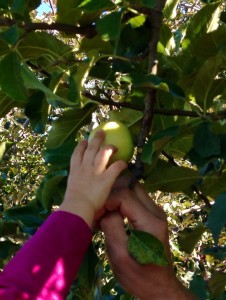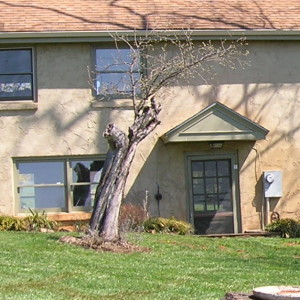 Affinity for horticulture has run in my family for generations. It started with my great-grandfather, Dr. Francis Clements, a country physician and plant whisperer. I learned of his botanical prowess through stories passed down by relatives who intrigued me with tales of the man’s masterful ability to create spectacularly brilliant fruit trees, roses, and prolific gardens. In time, his talents trickled down over the generations and found their way to my mother, and eventually, to me.
Affinity for horticulture has run in my family for generations. It started with my great-grandfather, Dr. Francis Clements, a country physician and plant whisperer. I learned of his botanical prowess through stories passed down by relatives who intrigued me with tales of the man’s masterful ability to create spectacularly brilliant fruit trees, roses, and prolific gardens. In time, his talents trickled down over the generations and found their way to my mother, and eventually, to me.
I love getting my hands in dirt, and much of my free time is spent toiling away in a small garden a few yards from my home. There, with the passing of each season, I continually hone my skills, trying out new techniques for working the soil, crop placement and pest control. Eventually, my efforts pay off in a cornucopia of fruits and vegetables ranging from spineless okra, Silver Queen corn and black-eyed peas to brandy wine tomatoes, Georgia collards, and sugar-baby watermelons; year-in and year-out, I witness the Earth delivering its bounty and feeding my family.
Over time, I’ve learned how to give crops the best chance of survival and to boost their production with irrigation systems, fertilizers and pesticides, and, of course, good old fashioned tilling, hoeing, and weeding. I’ve also picked up some life lessons along the way; plant life unapologetically reveals the fact that so many things are simply out of our control, like the weather, the unpredictable nature of insects and disease, and of course, the humbling and frustrating experience of natural disasters.
Sometimes, however, the things you can’t control have a way of mingling with the things you can control, yielding unexpected results. Pruning is an example of this, and it’s a phenomenon that occurs in nature all the time (without the help of humans). You see it when a tree branch is snapped off from the weight of ice build-up in winter, or when a deer nibbles buds from your favorite ornamental, both of which inevitably cause new growth—especially in fruit-bearing trees.
The same benefits can be gained when you intentionally prune in the very late fall, causing a rush of new growth the following spring. This simple practice—(sometimes overlooked, even by seasoned gardeners)—is crucial for increasing bud production and fruit yield, and also for revitalizing a plant when it’s in trouble.
So here’s what happened: In February 2003, my wife and I relocated to the beautiful, historic township of Keswick, Virginia. Nestled on a gentle slope between ponds and horse pastures, we moved into a quaint little cottage—a refurbished 1823 stone apple orchard packing house, sitting on a 2300-acre cattle farm that poured down the eastern side of a mountain and sprawled out for nearly 2 miles. For 6 years, Amanda and I called this picturesque setting home.
 Just 10 yards from our kitchen window, I met my beloved friend—the main character of this love story—an ancient apple tree that had been weathered and ravaged over centuries. Its limbs were spindly and stretched out in all directions; its trunk was nearly rotted-out, and its bark was riddled with thousands of tiny holes where woodpeckers had relentlessly pursued insects-in-residence.
Just 10 yards from our kitchen window, I met my beloved friend—the main character of this love story—an ancient apple tree that had been weathered and ravaged over centuries. Its limbs were spindly and stretched out in all directions; its trunk was nearly rotted-out, and its bark was riddled with thousands of tiny holes where woodpeckers had relentlessly pursued insects-in-residence.
This failing tree, probably the same age as the building we occupied, and likely, the last standing apple tree on the farm, was hanging onto its life by a thread. It would’ve been easy enough to give up on this tree, but I could tell by the buds on the tips of its branches that it still had life in it, and I could hardly wait ’til April to see what it had in store for us!
Something exciting happened in the spring of that year. This primeval-looking tree exploded with delicate pink blossoms and a profusion of green sprigs. After the peak in late April, I couldn’t wait for the golden crisp treat that would surely arrive in the fall! I anticipated the aroma of a cobbler baking in the oven, and could taste the sweet crunch of freshly picked APPLES on my lips.
I knew I had my work cut out for me, and I went straight to it—watering and fertilizing the tree on a strict schedule—weeding and mulching the ground around her roots as if to put a shawl around a beloved grandmother. There was no doubt in my mind that all this attention and nurturing would result in a generous harvest!
By the time summer rolled around, I was bewildered to count only 5 apples, each of which, the size of ping pong balls. Even so, those were 5 prized possessions, and nothing was going to prevent me from enjoying them. Unfortunately, I would never get the opportunity to taste any of them.
It was mid-September, and the apples were almost ready to be picked. The color of the evening sky was a brilliant red and purple—one of the most beautiful sunsets I’d ever seen. I inhaled deeply, and became instantly restless as an ominous aroma, floating on the southeast breeze, wafted into my nostrils. Having grown up by the ocean, I recognized this faint stench from the sea, and I knew it could only mean one thing.
Within 24 hours, Hurricane Isabel turned inland and was bearing down on Central Virginia. The wind gusts were clocked at over 100 miles an hour. Massive trees were torn from their roots and strewn everywhere. I could see the apple tree outside my window, battered and whipped around in the maelstrom.
The next morning, there was too much debris outside to get a clear view from the kitchen, and I reluctantly opened the back door to survey the damage. The house had lost several shingles. A huge locust tree had been thrown across the yard and shattered the deck and fence. Two 70-ft. white pines had narrowly missed our cars by just a few inches. Then I came to the apple tree. Many limbs were missing, the trunk had split, and the roots could be easily rocked out of the ground. I was saddened to realize my old friend probably wouldn’t survive the winter.
The story takes a happy turn in the early spring. The leaves, having fallen off and leaving the branches bare, gave me the opportunity to inspect the apple tree more closely. There was one, tiny, 1½ inch sprig emerging near the top of the massive crack in the trunk caused by the storm. I followed the new growth around the trunk and noticed a slightly-raised ridge that ran down the length of one side and straight into the ground. It looked as though the tree was willing itself to live, clinging to this single lifeline of hope. Then I remembered…
I ran into the house and found a pair of pruning shears and began carefully shaping the small sprig. Over the next 3 weeks, I strategically trimmed off the other dead portions of the tree, mindful to not over-prune which would cause the tree to fall dormant or perhaps even die.
When spring arrived, I witnessed a thunderous growth erupting out of the well-manicured branch, and the blooms were massive and gorgeous! Over the next 2 months, the original tiny sprig of new life grew in diameter and length, and by summer it was a thick branch no less than 3 feet tall. There was new growth coming from the spots where the old branches had snapped off, and new growth on the ridge along the trunk as well.
By 2005, the tree was producing over 100 of the best-tasting golden apples every season. After 3 years of deliberate pruning, it was difficult to distinguish the old branches from the new because all you could see was a beautiful, hearty tree, producing an abundance of apples—more and more apples with each passing year! I often stared at this old tree, amazed at its ability to bring forth so much brilliance and regeneration…and so much life!
In the spring of 2009, Amanda and I decided to leave our little cottage on the farm, and I had to say goodbye to my old friend. As we pulled out the driveway, I could see the tree getting smaller and smaller in my rear-view mirror. I smiled with great satisfaction, stealing one last look at the beautiful canopy of blooms that were borne of disaster—a disaster that created an opportunity for something to grow: a tree standing strong and bearing fruit to this day.




